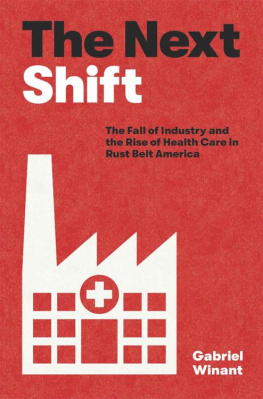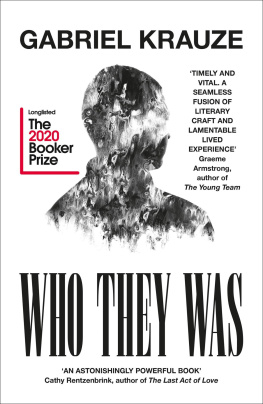Gabriel Winant - The Next Shift
Here you can read online Gabriel Winant - The Next Shift full text of the book (entire story) in english for free. Download pdf and epub, get meaning, cover and reviews about this ebook. year: 2021, publisher: Harvard University Press, genre: Politics. Description of the work, (preface) as well as reviews are available. Best literature library LitArk.com created for fans of good reading and offers a wide selection of genres:
Romance novel
Science fiction
Adventure
Detective
Science
History
Home and family
Prose
Art
Politics
Computer
Non-fiction
Religion
Business
Children
Humor
Choose a favorite category and find really read worthwhile books. Enjoy immersion in the world of imagination, feel the emotions of the characters or learn something new for yourself, make an fascinating discovery.
- Book:The Next Shift
- Author:
- Publisher:Harvard University Press
- Genre:
- Year:2021
- Rating:5 / 5
- Favourites:Add to favourites
- Your mark:
- 100
- 1
- 2
- 3
- 4
- 5
The Next Shift: summary, description and annotation
We offer to read an annotation, description, summary or preface (depends on what the author of the book "The Next Shift" wrote himself). If you haven't found the necessary information about the book — write in the comments, we will try to find it.
The Next Shift — read online for free the complete book (whole text) full work
Below is the text of the book, divided by pages. System saving the place of the last page read, allows you to conveniently read the book "The Next Shift" online for free, without having to search again every time where you left off. Put a bookmark, and you can go to the page where you finished reading at any time.
Font size:
Interval:
Bookmark:
The Next Shift
THE FALL OF INDUSTRY AND THE RISE OF HEALTH CARE IN RUST BELT AMERICA
Gabriel Winant
HARVARD UNIVERSITY PRESS
Cambridge, Massachusetts
London, England
2021
Copyright 2021 by the President and Fellows of Harvard College
All rights reserved
Jacket design: Monograph / Matt Avery
978-0-674-23809-1 (cloth)
978-0-674-25979-9 (EPUB)
978-0-674-25983-6 (PDF)
Publication of this book has been supported through the generous provisions of the Maurice and Lula Bradley Smith Memorial Fund
The Library of Congress has cataloged the printed edition as follows:
Names: Winant, Gabriel, author.
Title: The next shift : the fall of industry and the rise of health care in Rust Belt America / Gabriel Winant.
Description: Cambridge, Massachusetts : Harvard University Press, 2021. | Includes index.
Identifiers: LCCN 2020041877
Subjects: LCSH: Medical economicsNortheastern States. | Medical economicsMiddle West. | Community health aidesNortheastern States. | Community health aidesMiddle West. | IndustriesNortheastern States. | IndustriesMiddle West. | Northeastern StatesEconomic conditions. | Middle WestEconomic conditions.
Classification: LCC RA410.54.U6 W56 2021 | DDC 338.4/736210974dc23
LC record available at https://lccn.loc.gov/2020041877
To my parents, Debbie Rogow and Howie Winant, who have always dreamed of a better world and indeed made one for their children.
History is what hurts.
FREDRIC JAMESON, The Political Unconscious: Narrative as a Socially Symbolic Act

The Pittsburgh area
I n 2013, Pennsylvanias largest private employer claimed before federal regulators that it has no employees. This institution, the University of Pittsburgh Medical Center (UPMC), added that it conducts no operations and engages in no employee or industrial relations activities. This argument surprised many because UPMC, a health care giant, dominates the regional economy. It looms over Pittsburgh from US Steel Tower, the tallest building in the skyline, on top of which the giant letters UPMC have replaced USS. And the massive health care system today employs more than eighty-five thousand peoplelegal claims notwithstanding. Where did all the workers go?
The hospital chains claim of having no employees, made in the context of disputes over its employment practices and tax status, rested upon a legal distinction between the parent company and its subsidiary entities. Because of its organizational structure, UPMC argued, it was not obligated to act in ways expected of an employer. This contention put UPMC in the growing camp of employers in all industries seeking to avoid responsibility for employments costs through the use of subcontracting or misclassification of workers as independent contractorsa phenomenon known as the fissuring of the workplace. A 2018 magazine feature on the subject used UPMCs practices for its central example, telling the story of the outsourcing of the job of medical transcriptionist Diana Borland to a contractor that paid her per line rather than per hour. As a UPMC employee, she had earned $19 per hour, enough to support a solidly middle-class life. Her first paycheck at the per-line rate worked out to just $6.36 per hour.
While UPMCs claim was tactical chiseling at one level, at another the assertion also symbolizes a profound paradox in the American political economy: care workers are at once everywhere and nowhere. They are responsible for everyone, but no one is responsible for them. The practice of fissuring is only one formalized manifestation of this deeper phenomenon.
In a large-scale pattern often described as the polarization or dualization of the economy, profits accrue increasingly to firms that do not generate mass employment, while labor simultaneously accumulates in low-margin industries far from profits. The accumulation of capital is more and more decoupled from employment not just by formal corporate structures but also by the mix of commodities that human labor is required to produce. What has changed is not just the corporate organization of labor markets but also, beneath it, the social division of labor.
This change has meted out severe social consequences. High-employment, low-profit industriessuch as health care, education, and social servicesexperience constant downward pressure on their margins as a result of these industries limited opportunities for productivity gains, a problem inherent to the provision of human services. The pattern even plays out inside the bounds of a given industry like health care, as pharmaceutical companies, insurers, and medical technology firms capture the profits, while hospitals, home health agencies, and nursing homesthe engines of employmentoperate less profitably, further down the value chain. Unable to achieve steady advances in efficiency of production, such employers instead sustain themselves financially by increasing prices and suppressing wages. I have not received a raise for approximately 10 to 12 years from my employer, and I pay the same price for bread as they do, one Pittsburgh hospital worker testified in 2015.
This category of labor-intensive, low-productivity, low-wage industries has grown rapidly in its share of overall employment. Such a possibility is intrinsic in the transition from an industrial to a service economy, although specific political institutions elaborate or inhibit this possibility, leading to international variation. Everywhere across the global North, as the power of the organized working class collided with declining manufacturing profits, a sectoral transformation ensuedand the care economy expanded, within the public sector or adjacent to it.
The choice for capitalist democracies, social scientists observe, forms a trilemma: a three-way choice between unemployment, low wage growth, or high public deficits. Institutional particularities at the national or subnational level, shaping the extent and contours of inequality, represent elaborations of this underlying general predicament. There are huge areas of servicing which are labour intensive and low-skilled. The lower end of servicing society is where we must pin our hopes for mass employment, observes Gsta Esping-Andersen. Unfortunately, because of their sluggish productivity, low-end service jobs are threatened by a long-run cost-disease problem. [Service-sector] employment is therefore likely to stagnate unless wages slide downwards. Hold wages down to encourage job creation, accept high unemployment in return for good wages, or embrace costly direct state intervention in employmentthese are the contours of the trilemma.
In the United States, through our hybrid public-private welfare state, we have selected the option of mass low-wage private-sector employment. Exploitative working conditions for some, however, enable security for others, because the millions of jobs that have proliferated at the bottom of our dual economy originate, to an astonishing degree, in the rising care economy. This category encompasses the provision of direct and indirect services to develop and sustain human capacities, including tending to the young, old, disabled, and sick and supporting daily life through housekeeping, food service, and domestic work. While all these categories of employment have expanded markedly, health care accounts for the largest part of the care economy phenomenon.
In the bottom quintile of the American wage structure, the care economy accounted for 56 percent of all job growth in the 1980s, 63 percent in the 1990s, and 74 percent in the 2000s. The workers who do not existwhom UPMC disavowedare found here, in vast and growing numbers, in the lowest strata of the labor market, their multiplication driving the overall increase of inequality. Insofar as this sector of employment has long been demarcated as a degraded one assigned largely to women, especially women of color, this polarization dynamic also represents the stubborn reproduction of racial and gender hierarchy in and through labor market processes. Equally, the reconstruction of labor markets since industrial decline has depended on preexisting hierarchies of race and gender.
Font size:
Interval:
Bookmark:
Similar books «The Next Shift»
Look at similar books to The Next Shift. We have selected literature similar in name and meaning in the hope of providing readers with more options to find new, interesting, not yet read works.
Discussion, reviews of the book The Next Shift and just readers' own opinions. Leave your comments, write what you think about the work, its meaning or the main characters. Specify what exactly you liked and what you didn't like, and why you think so.













